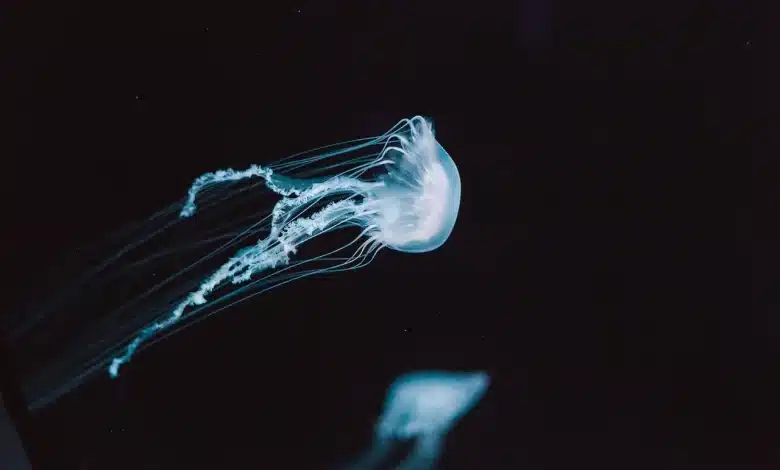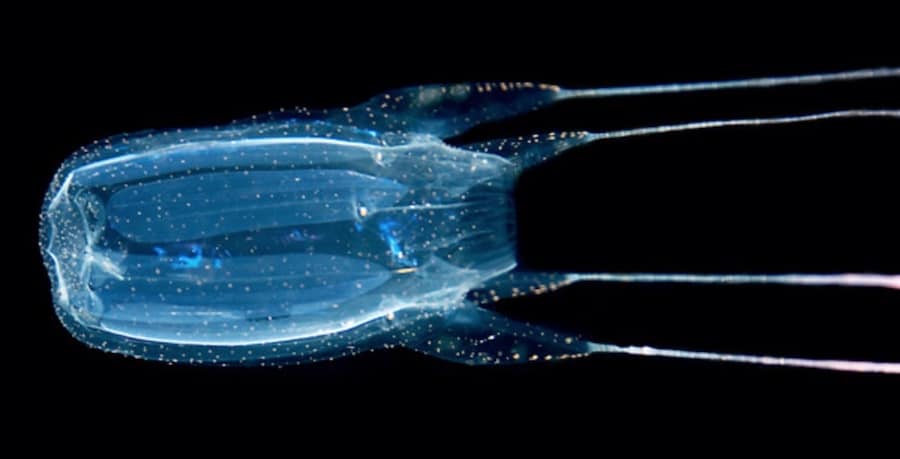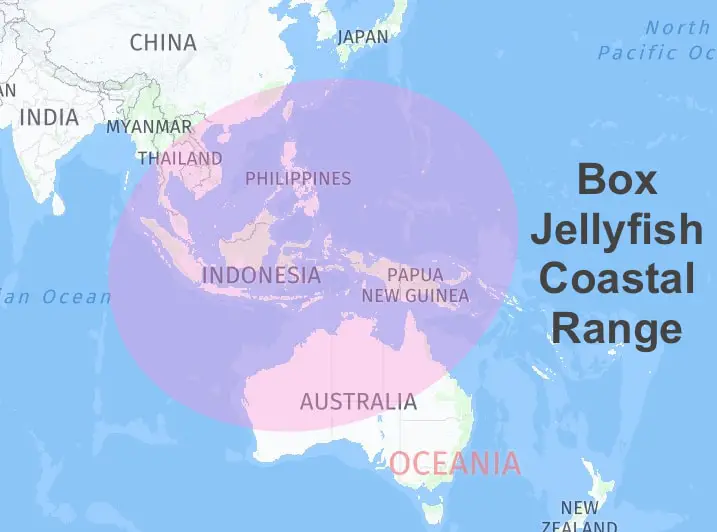Box Jellyfish Facts and Treatment – Thailand, Worldwide


Box Jellyfish Facts – Must Read
[Page updated: 6 May 2023]
Box jellyfish are part of the invertebrates from the phylum: Cnidaria. These are stinging animals which do so for protection, and to freeze prey so they can consume it – fish, for instance, not people.
Box jellyfish are important for people to become aware of if you are going to be living or vacationing in an area where box jellyfish are located. Stings cause indescribable pain, and sometimes death.
The distribution range of box jellyfish is shown in the map below.

First-Hand Box Jellyfish Sting Experience
I know exactly what a box jellyfish sting feels like. I was snorkeling on the island of Maui, in Hawaii in 2003 when I was stung. I was done snorkeling, and just sitting in the shallow taking off my gear when I felt a sting on my inside thigh.
I thought nothing of it, then it became annoying so I brushed it with the back of my hand. It burned more – and I looked underwater with my mask still on. I saw nothing. I kept removing my fins and mask.
Then it REALLY burned – like fire. I looked again – it was red, but no sign of a jellyfish. Then the pain multiplied by about a thousand and I screamed from the water to my friend to get our stuff packed up because we were going straight to the hospital.
We did, and I was treated for box jellyfish stings to my inside thigh. The pain was horrific. It was astounding to me because I’m no stranger to pain, living a rather adventurous life, but this was another level altogether. Another world of pain I hope you never experience.
When I think back on it, it’s even more amazing to me that the pain was so intense because on the inside of your leg, you don’t have nearly as many nerves – pain receptors – as in your hand, foot, or face… I am SO lucky not to have been stung on one of those areas. Other people are not so lucky.
Believe me when I say, the pain was as if someone was pouring battery acid on my leg non-stop for 2+ hours until the doctor applied some heat packets. I didn’t even mention the scary part. My heart was beating like MAD. My breathing was closing down… and I was getting delirious. I couldn’t put thoughts together correctly. It was quite a bad scenario.
Read all about box jellyfish below and do EVERYTHING YOU CAN to AVOID THEM.
Box Jellyfish Appearance
Small – a few inches in diameter and height, box jellies are not the big jellyfish you see in the water (which can also sting painfully). One of the most potent box jellyfish is about a centimeter (less than 1/2 inch) wide and long – the Irukandji (Malo kingi) – in the waters of northern Australia.
Sort of squarish (see top page image), the box jellyfish has the typical bell-shaped body mass, but it is roughly square and not as round as most other jellyfish. There are a number of species. Species names and ranges are listed below.
- Carukia barnesi – a species of Irukandji in Australia. .5 to 1.2 inches across. Tentacles may be 1.6 feet long.
- Carybdea alata – Hawaii, Thailand, across the globe.
- Carybdea rastoni – Hawaii
- Carybdea Sivickisi – Hawaii
- Chironex fleckeri – large like a basketball. Sixty 3m (10 feet) long tentacles – 15 on each corner. Known as the “Sea Wasp” – most deadly jellyfish in world with 64 deaths in Australia as of 2018.
- Malo kingi – a species of Irukandji jellyfish inhabiting northern Australian waters.
Box jellyfish have four long tentacles that extend from the square corners of the body. Each can be up to a meter long. Box jellyfish have balance and light sensors. They move toward light in experiments and are quick swimmers compared to other jellyfish.
Box Jellyfish Predators
Sea turtles love box jellyfish and eat them in large numbers when available. They seem to be immune to the stinging cysts. Other predators include crabs and a number of different fish like butterfish, rabbitfish and batfish.
Box Jellyfish Diet
They eat small fish and other prey like shrimp that are caught in their tentacles and paralyzed by their strong venom. They also are known to eat small crustaceans.
Box Jellyfish Prefer Saltwater Environment
Box jellyfish are typically found in shallow tropical seas which are warm and calm. They inhabit quiet water of bays and estuaries near sandy shorlines. Sometimes found in the open ocean. In daylight – they can be found on the bottom.
In summer, they tend to be near the surface – and are more of a danger to swimmers and others in the ocean.
Jellyfish tentacles are equipped with cell-sized stingers called nematotocysts which fire when touched or activated chemically. The barb penetrates skin easily and venom is instantly injected.
Box Jellyfish Treatment
The top researchers at the University of Hawaii have recommended that vinegar be used to stop the stinging jellyfish cells from firing and injecting more venom. An Australian website insists that adding vinegar causes jellyfish cells to inject as much as 50% MORE venom than they had already. I’m clearing up the discrepancy now with emails to both.
UPDATE – OK – I have an answer. Apparently the study which found that more venom was found in a solution during an experiment after vinegar was added – was not well controlled and the results were not generalizable from that experiment to apply to what occurs with human skin during a stinging episode.
The recommendation is still to USE VINEGAR OVER THE AFFECTED AREA FOR AT LEAST 30-seconds. LONGER if possible.
Traditional treatment have always recommended vinegar and heat be applied.
Toxinology.com – the site I usually visit to find out about treatments for venomous snakebite has the following steps for first aid in the case of box jellyfish envenomation.
1. Remove the victim from the water, at all times being aware of the potential for further stings, both to the victim and rescuers. If possible wear protective clothing, such as stinger suits or pantyhose. Be careful not to touch undischarged tentacles on the victim with bare skin, as this may result in the rescuer also being stung.
2. Immediately douse the entire stung area with copious quantities of vinegar for at least 30 seconds.
3. Assess vital functions, especially airway, breathing and circulation. Apply respiratory and cardiac support, as appropriate. If there is cardiac arrest, commence full resuscitation in an optimistic fashion and continue until medical care is reached.
4. If there is major envenoming with cardiac complications or arrest or respiratory complications, and CSL Box Jellyfish Antivenom is available at the beach, give 3 ampoules intramuscularly (providing those administering are trained to do so). If suitably trained personnel are available to give antivenom IV, then this is preferable to IM.
5. If available, give oxygen. Entonox (nitrous oxide), if available, may be used for pain.
6. Urgently transport the victim to medical care.
For treatment suggestions – toxinology.com suggests ice. This goes contrary to everything I’ve ever heard about treating envenomation of anything. Heat breaks down the venom, not ice. In Hawaii, they also recommend heat packs – at 45°C (about 117°F).
I would strongly suggest you don’t apply ice. Again, I’ll send email and find out why there are two supposedly qualified professional groups recommending opposite treatments.
Box Jellyfish Antivenom
Antivenom Code: MAuCSL01
Antivenom Name: Box Jellyfish Antivenom
Manufacturer: CSL Limited
Phone: ++61-3-9389-1911
Toll free: 1 800 642 865
Address: 45 Poplar Road, Parkville, Victoria 3052
Country: Australia

Thanks for the helpful advice. Are box jellyfish equally likely on all of Ko Lanta’s beaches or some more than others? Some Lanta beaches like Ao Kantiang are pretty wavy which would go against what boxes’ preferred conditions are. Cheers.
Good questions… not sure. I’m not an expert on Thailand’s box jellyfish, I just researched it a bit to see if I could post some useful info.
I also read baking soda along with vinegar can help. How do you feel about that piece of information? Does it sound bogus or it makes sense ?